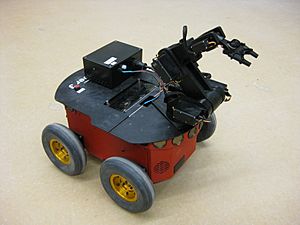Denning Mobile Robot Company facts for kids
The Denning Mobile Robot Company in Boston was one of the first companies to create ready-made autonomous robots. These robots were mainly bought by scientists and researchers. Other early companies included Grinnell More's Real World Interface, Inc. (RWI) and James Slater's Nomadic Technologies in the US, along with Francesco Mondada's K-Team in Switzerland. They all helped provide robots for robotics research.
RWI made a robot called the B-21, Nomadic created the XR4000, and the small Khepera mobile robot came from the Swiss K-Team. However, these robots were very expensive. Only a few advanced students and military researchers could afford them. Then, in 1995, the more affordable Pioneer robot was introduced. This robot was a team effort between RWI and ActivMedia Robotics. Its lower price helped many more people start researching mobile robotics.
Contents
History of Mobile Robot Companies
By 1999, the Denning company was no longer in business. In 1998, RWI joined with ISRobotics to form iRobot. This company became well-known for its PackBot remote control robot. iRobot shifted its focus from research robots to making robots for military uses. Nomadic Technologies also stopped making research robots. However, MobileRobots Inc and K-Team continued to provide robots for the research community.
In 2003, the Defense Advanced Research Projects Agency (DARPA) asked Segway to change fifteen Segway PTs into Segway Robotic Mobility Platforms. Segway delivered these units to DARPA in April. In June, DARPA worked with SPAWAR Systems Center San Diego to give these robots to 14 government and university research groups.

During the 1990s and 2000s, research robots got much better at moving around indoors by themselves. Ready-made robot bases offer the necessary sensors, movement, and computer power. Examples include the Pioneer, PatrolBot, PowerBot, and PeopleBot.
These robots can create maps of buildings and find their way around right out of the box. They use a method called SLAM. This means the robot builds a map of its surroundings while figuring out where it is on that map at the same time. They also use other smart techniques with sensors that can measure distances, like 2-D range-finders. This method creates a map that humans can easily understand. This map helps control and track the robots as they move.
Evolution Robotics offers software that uses a single camera for VSLAM (Visual SLAM). This system uses visual pattern-matching instead of measuring distances. However, it cannot create a human-readable map. Other groups are building VSLAM systems that use two cameras, like human eyes. Because two cameras can provide distance information, these systems can make maps and track robots. The K-Team Khepera, Segway-based robots, and other research robots can connect to outside computers to use this kind of software.
How accurate a robot's navigation is depends on how precise its sensors are and how fast it can calculate. Laser range-finders can be accurate to about +/-1 centimeter. Digital stereo cameras are less precise, with accuracy depending on the distance. Vision-based systems need more computer power than simple laser systems. However, they might have a special computer chip built into the camera to help. Cheaper vision-based systems are often found in robots for homes. More expensive laser-based systems are usually used in commercial and industrial robots and automated guided vehicles (AGVs).
Outdoors, robots mainly use GPS to figure out where they are. However, satellite signals can often be lost if there are buildings or trees in the way. When GPS signals are lost, robots typically use dead reckoning and inertial motion tracking. Dead reckoning relies on how much the robot's wheels turn. This method can build up errors over time if the wheels slip. Inertial motion tracking uses special sensors called rate gyroscopes and accelerometers to measure movement. How accurate this is depends on the quality of the sensors and how well they are set up.
The Segway RMP 400 and Seekur robots are two platforms designed for outdoor research. Most other outdoor research robots are often built from existing vehicles. In smaller outdoor areas, some robots, like the John Deere Gator, simply use radio beacons placed around the edge of the area. They use a method called triangulation from three or more beacons to find their location and navigate. Beacons are also used indoors by older AGVs in factories.
How Robots Are Programmed
Much of the software used for research on autonomous robots is Free Software or Open Source Software. This means it can be used, changed, and shared freely. Examples include Robot Operating System, Carmen from Carnegie Mellon, and Player/Stage/Gazebo from the University of Southern California. The ARIA APIs from MobileRobots Inc. are also used. URBI, which has a Free Software SDK (Software Development Kit), is used in many universities.
There is also commercial software available. Webots has been developed since 1998 and is used by over 500 universities. It works on Linux, Windows, and Mac OS X computers. In June 2006, Microsoft Research started offering free test versions of its Robotics Studio software development kit. This software could be used with Pioneer robots in a simulated environment on Windows XP.

